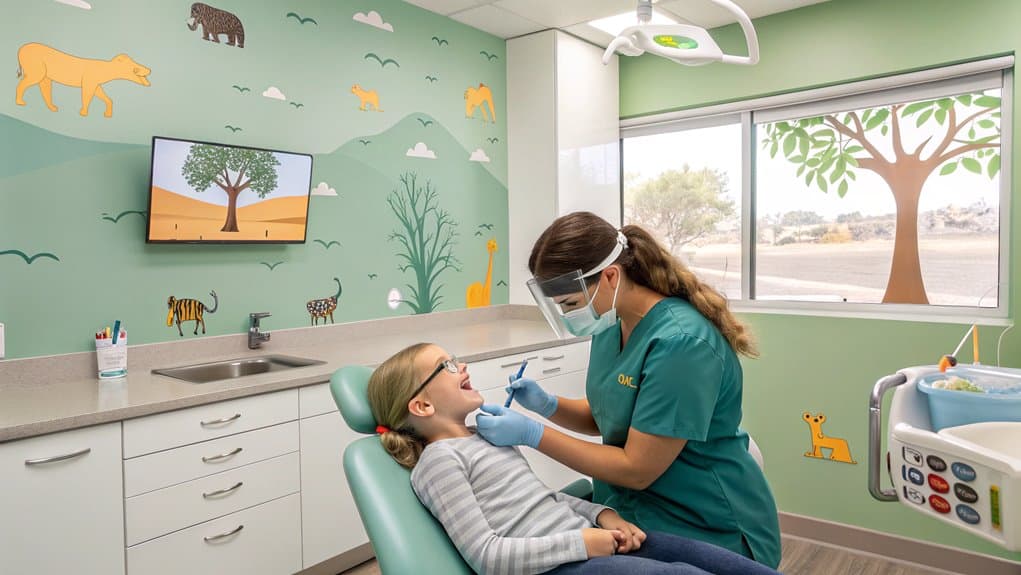Advanced Pediatric Dental Trauma Management Strategies for East Mesa’s Active Children
Quick Take: Managing dental trauma for East Mesa’s active children requires prompt emergency care combined with specialized long-term treatment to ensure optimal recovery and prevention.
Children involved in sports and active play face a constant risk of dental injuries that can cause both physical pain and emotional distress. When these accidents happen, immediate and expert care is crucial to preserve the affected tooth and prevent long-term complications.
Beyond emergency treatment, today’s pediatric dental trauma management focuses on advanced specialist care that promotes healing and restores full function. From regenerative biomaterials to modern splinting techniques, these innovations—along with preventive education and protective gear—help children recover quickly and keep their smiles safe during play.
Key Takeaways
- Implement rapid trauma response protocols tailored for East Mesa’s youth sports facilities and schools, emphasizing correct tooth preservation and immediate care steps.
- Partner with local pediatric dental specialists to ensure quick emergency treatment and thorough follow-up care.
- Use advanced diagnostic tools, such as laser Doppler flowmetry, to accurately assess dental injuries in active children.
- Develop customized protective gear programs focused on common regional activities, highlighting the importance of proper mouthguard use during sports.
- Create digital education platforms for East Mesa’s community to train school staff and coaches in effective dental trauma management.
Understanding Dental Trauma Patterns in Active Children
Key Insight: Active children face distinct dental trauma risks influenced by age, activity type, and anatomical factors, necessitating targeted prevention strategies to safeguard oral health.
Children’s dynamic physical activities, while essential for growth and coordination, inherently increase the likelihood of dental injuries. Understanding the biomechanics of dental trauma across developmental stages—such as toddlers’ falls leading to primary tooth damage and school-aged children’s sports-related injuries—provides critical insights for tailored protective measures. Recognizing patterns in injury mechanisms enables caregivers and professionals to anticipate and mitigate risks effectively.
Analyzing specific factors like injury location, gender disparities, and activity context deepens our comprehension of trauma prevalence. This knowledge informs evidence-based interventions, from orthodontic assessments to sports safety protocols, enhancing pediatric oral health outcomes. That’s why integrating biomechanical data with preventive care empowers parents and clinicians to reduce dental trauma incidence meaningfully. Additionally, early orthodontic evaluation plays a critical role in identifying anatomical risk factors that contribute to dental injuries.
Crucial findings highlight:
- Maxillary central incisors consistently bear the highest injury rates across all childhood stages.
- Boys exhibit a statistically higher incidence of dental trauma compared to girls, reflecting behavioral and activity differences.
- Sports-related dental injuries predominantly occur during training sessions (87.3%) rather than competitive events (12.7%).
- The most common injury types include tooth mobility (58%) and crown fractures (36.4%), indicating varying biomechanical impacts.
- Anatomical risk factors such as increased overjet and insufficient lip coverage can triple the likelihood of trauma, underscoring the importance of early orthodontic evaluation.
Emergency Response Protocols for Tooth Injuries
Key Insight: Rapid, precise emergency responses following dental trauma significantly improve outcomes for children by prioritizing tooth preservation, proper documentation, and specialist intervention, while also addressing anxiety through dental sedation when needed.
Immediate and structured assessment after tooth injuries is essential to mitigate complications and preserve oral health. Emergency responders must integrate trauma evaluation with tailored preservation strategies, recognizing the distinct needs of primary versus permanent teeth. Incorporating dental sedation has enhanced the management of anxious or uncooperative pediatric patients, ensuring thorough examinations and effective treatment.
Collaboration with dental specialists streamlines advanced care for complex injuries, optimizing recovery trajectories. Maintaining detailed injury records and employing evidence-based preservation methods bolster clinical decision-making and patient outcomes. This comprehensive approach reflects evolving best practices in pediatric dental trauma management.
Critical emergency response steps include:
- Immediate assessment of bleeding severity and consciousness level, with prompt activation of emergency medical services for critical cases.
- Careful handling and storage of avulsed teeth, preferably in milk or specialized transport media, to maintain cell viability for potential reimplantation.
- Application of gentle pressure using sterile gauze to control hemorrhage, avoiding aggressive rinsing that may exacerbate tissue damage.
- Rapid referral to pediatric dental or oral surgery specialists for evaluation and intervention in complex or multiple tooth injuries.
- Accurate differentiation between deciduous (primary) and permanent dentition to guide urgency and preservation strategies.
- Utilization of dental sedation techniques when necessary to facilitate comprehensive examination and treatment in anxious or non-cooperative children.
Additionally, establishing a strong foundation for lifelong oral health can help mitigate the long-term impact of dental trauma by promoting regular dental visits and preventive care. Effective management of dental trauma hinges on swift, evidence-informed action that balances immediate care with long-term preservation goals. That’s why empowering emergency teams with clear protocols and specialist collaboration is vital to safeguarding children’s oral health. Moving forward, integrating sedation judiciously and documenting injury specifics will continue to enhance treatment precision and patient comfort.
Evidence-Based Treatment Options and Specialist Care
Key Insight: Effective pediatric dental trauma care hinges on evidence-based protocols that prioritize timely intervention, specialist expertise, and advanced biomaterials to optimize healing and long-term tooth preservation.
As a result of evolving clinical research and authoritative guidelines from the International Association of Dental Traumatology (IADT), pediatric dental trauma management now emphasizes rapid, precise treatment tailored to injury type and patient age. Integrating epidemiological insights and innovative regenerative techniques has improved prognosis for both permanent and primary teeth, ensuring developmental integrity and functional restoration. Expert care coordinates emergency response with ongoing monitoring to preempt complications like pulp necrosis or root resorption.
Pediatric dental specialists leverage sedation options to facilitate complex procedures in young or anxious patients, enhancing treatment efficacy and patient comfort. That’s why contemporary care protocols incorporate bioactive materials such as mineral trioxide aggregate (MTA) and bioceramic sealers, which promote tissue regeneration and durable sealing. Regular follow-up appointments and modern splinting methods further support healing and stability, underscoring a holistic, multidisciplinary approach to dental trauma recovery. Additionally, early orthodontic care can play a vital role in ensuring that any dental trauma does not negatively impact a child’s developing smile.
Key components of evidence-based pediatric dental trauma care include:
- Timely tooth replantation within the critical 60-minute window to maximize periodontal ligament viability.
- Age-specific treatment strategies differentiating approaches for primary versus permanent dentition to safeguard developing teeth.
- Use of advanced bioactive materials like MTA and bioceramics that enhance pulp healing and prevent infection.
- Sedation protocols tailored for pediatric patients to ensure procedural success and reduce anxiety-related complications.
- Modern splinting techniques that stabilize injured teeth while allowing physiological mobility for optimal recovery.
- Comprehensive follow-up monitoring to detect and manage late-onset complications such as root resorption or pulp necrosis promptly.
Embracing a multidisciplinary, evidence-driven mindset transforms pediatric dental trauma outcomes from reactive to proactive care. Understanding the nuances of treatment timing, material science, and patient management empowers clinicians and caregivers alike to champion the best possible prognosis. By prioritizing expert intervention and longitudinal care, families can confidently navigate dental emergencies with assurance and resilience.
Long-Term Monitoring and Follow-Up Strategies
Key Insight: Effective long-term monitoring of pediatric dental trauma hinges on customized follow-up protocols that address each patient’s specific injury type and developmental stage, ensuring comprehensive healing and preventing complications through advanced diagnostic and behavioral strategies. Consistent evaluation and documentation foster proactive management and optimize treatment outcomes.
Implementing a tailored monitoring plan leverages cutting-edge technologies such as laser Doppler flowmetry and pulse oximetry, which provide objective assessments of tooth vitality over time. Integrating age-appropriate behavioral management techniques enhances cooperation in young children, facilitating accurate evaluations and appliance compliance. Dental professionals can adapt interventions dynamically, reducing the risk of sequelae like pulp necrosis or malocclusion. Additionally, utilizing Invisalign clear braces can offer a modern solution for orthodontic needs in pediatric patients, ensuring comfort and efficiency in treatment.
Key elements of successful long-term follow-up incorporate:
- Regularly scheduled clinical visits utilizing state-of-the-art diagnostic tools for precise pulp vitality tracking and early complication detection.
- Systematic documentation adhering to International Association of Dental Traumatology (IADT) protocols to ensure consistency and enable data-driven treatment adjustments.
- Age-specific monitoring intervals emphasizing specialized approaches for toddlers and preschoolers to address behavioral and physiological differences.
- Prolonged surveillance periods tailored to injury severity, focusing on preventing secondary issues that may compromise dental appliance integrity and function.
Fostering a meticulous and individualized monitoring regimen empowers clinicians to identify subtle changes in healing trajectories promptly. That’s why embedding these evidence-based strategies into routine practice not only enhances patient outcomes but also builds trust with families navigating pediatric dental trauma recovery. Moving forward, embracing a holistic, data-informed follow-up mindset will be pivotal in advancing pediatric dental care standards.
Prevention and Community Education Programs
Quick Take: Effective prevention strategies in community education significantly reduce dental injuries, especially among children, by enhancing awareness and practical use of protective gear during high-risk activities.
As a result of growing evidence supporting proactive measures, prevention and education programs have become essential in minimizing dental trauma in community settings. Schools serve as critical environments for these initiatives since most dental injuries occur during school hours, making targeted interventions highly impactful. Integrating training for school nurses and physical education teachers empowers frontline responders to manage dental emergencies efficiently, further reducing long-term complications.
Leveraging digital learning platforms enhances educators’ understanding of dental injury risks and response protocols, expanding reach and engagement. Despite legislative mandates like dental laws requiring protective equipment, parental awareness and adoption remain suboptimal due to barriers such as discomfort and perceived irrelevance. That’s why community-focused education must address both informational gaps and practical concerns, particularly in sports contexts where mouthguards and helmets provide crucial injury prevention.
Key prevention strategies embedded in successful community education programs include:
- Comprehensive training for school health personnel and coaches on emergency dental trauma management.
- Utilization of interactive e-learning tools to boost knowledge retention and real-time response skills.
- Awareness campaigns addressing parental misconceptions and promoting consistent use of mouthguards.
- Collaboration with local sports organizations to enforce protective gear policies during high-risk activities.
- Continuous monitoring and feedback loops to adapt educational content based on injury trends and community needs.
Additionally, integrating knowledge about tooth extraction treatment can help families understand the importance of immediate care following a dental injury.
Fostering a culture of prevention through tailored education empowers communities to proactively reduce dental injuries rather than merely responding to them. By focusing on both awareness and practical adoption of protective measures, especially in youth sports, stakeholders can create safer environments that preserve long-term oral health. That’s why investing in robust, adaptive prevention programs is not just beneficial but essential for sustainable community well-being.
In Summary
Nearly half of all children experience dental trauma before age 15, highlighting the importance of advanced pediatric dental care in East Mesa. Palm Valley Pediatric Dentistry & Orthodontics provides expert, evidence-based treatments and emergency care to manage these injuries effectively, ensuring young patients receive timely and precise attention to protect their oral health.
Through personalized follow-up care, preventive programs, and community education, their team helps families reduce dental injury risks and promote long-term wellness. By combining treatment, prevention, and awareness, Palm Valley Pediatric Dentistry & Orthodontics empowers children across Scottsdale, East Mesa, Chandler, and nearby areas to stay active and confident while keeping their smiles safe.







